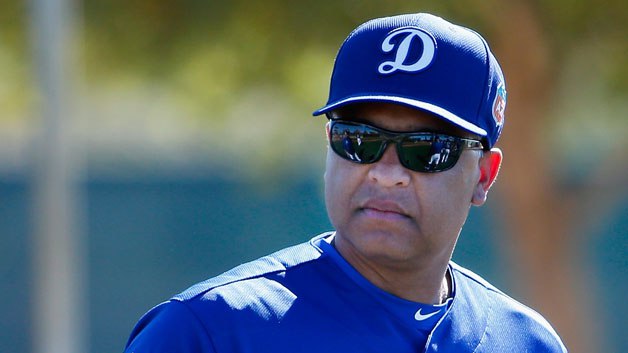
(Photo Credit: Christian Petersen/Getty Images)
If setup man Chris Hatcher would have successfully shutdown the Giants in the eighth inning of Friday night’s game, and Kenley Jansen enter the ninth to strikeout the side in trademark fashion, the Dodgers’ decision to remove rookie Ross Stripling amidst a no-hit bid through 7-1/3 innings would be considerably less controversial.
Instead, baseball writers and pundits across the country thrived on the outcome, composing articles with hypothetical finishes until the wee hours of the morning, ultimately questioning manager Dave Roberts‘ decision to not let Stripling finish what he started.
It’s almost senseless to join the debate, because logic says that Roberts made the correct move in going to the bullpen. The mystery to many Dodgers fans is how the 100-pitch count was initially decided upon for a rookie making his major league debut who went under the knife for a torn UCL almost two years to the day.
After all, Kenta Maeda was pulled after 85 pitches and six full innings of shutout ball on Wednesday, Scott Kazmir following 75 pitches of one-hit, shutout ball over six innings on Tuesday, and Clayton Kershaw after 83 pitches and seven innings of brilliance on Monday. Considering the time of year and the need to take every possible preventative measure to assure a healthy starting rotation, those pitch counts seemed fairly accurate.
Yet Stripling was permitted to continue his journey into the bottom of the eighth inning having already thrown 91 pitches. He would retire Brandon Crawford, then walk Angel Pagan on exactly his 100th pitch of the evening. That was it. And we all know how the remainder of the game played out through the bottom of the tenth inning.
Regardless, the problem wasn’t with the decision that Roberts made, but rather with the bullpen’s inability to shutout the Giants in the eighth and ninth innings to preserve the win for Stripling — a recurrence that’s broken the hearts of many Dodgers fans over the past several seasons.
In retrospect, there were only four reasonable options for the Dodgers’ coaching staff when Stripling left the game in the eighth. First, to use the squad’s best late game setup man, Hatcher, who was appointed to that exact role once the Aroldis Chapman deal fell through; second, to run out the team’s best reliever, Jansen, which probably would have created even more controversy if the outcome had gone awry; third, to hand the ball to the second-best setup option, Pedro Baez, who gave up a confidence deflating grand slam the night before; or finally, to trust in Louis Coleman or somebody else without much high leverage relief experience at the professional level.
We all know that Jansen has the tools to finish the job in proper fashion, but there’s only one Kenley to utilize a maximum of about four occasions per week, and as many times as the Dodgers have tried to clone him, they’ve yet to be successful.
Baez threw the ball with authority on Friday night, and the four-seamer actually appeared to have some movement, much unlike the center-cut pumpkin ball he threw to Hunter Pence the night before. There’s always been a ton of potential with Baez, but the Dodgers still remain unable to fully refine his talent. Consistency in command has always been the underlying problem with the converted third baseman.
Anyone with at least a little knowledge about pitching knows that Hatcher has the tools to succeed. His repertoire features a four-seam fastball, a two-seam cutter, a wicked slider and a nasty splitter. He throws them all with optimal velocity, and his control is generally stable, except for that one pitch that seemingly gets away from him once per inning that the opposition capitalizes on 75% of the time. For a pitcher with that much talent, it almost looks like he’s cursed in some type of eerie, mystical sense — anybody can see that Hatcher can flat out throw the baseball.
While incumbent pitching coach Rick Honeycutt is very well familiar with his bullpen, the positive light surrounding all of this is that Roberts is seeing firsthand the nuances and subtleties of his relief corps, and has plenty of time to make any necessary adjustments that he deems appropriate. Perhaps the answer does indeed lie with making one final effort to improve Hatcher’s command, giving Coleman a shot at the setup role, a free agent on another team, or even a hard throwing prospect on the Dodgers’ farm.
The fact of the matter is that two disappointingly ugly games this early, even if they are against the club’s biggest divisional rival, do not dictate the outcome of a 162-game season, so long as the players, the coaches and the front office learn from what is being unfolded in front of them and make some sort of concerted effort to improve the situation moving forward.
